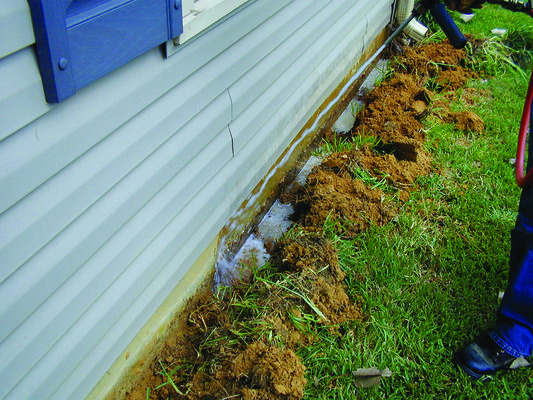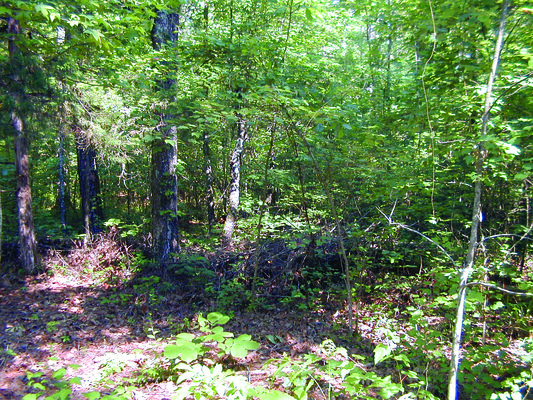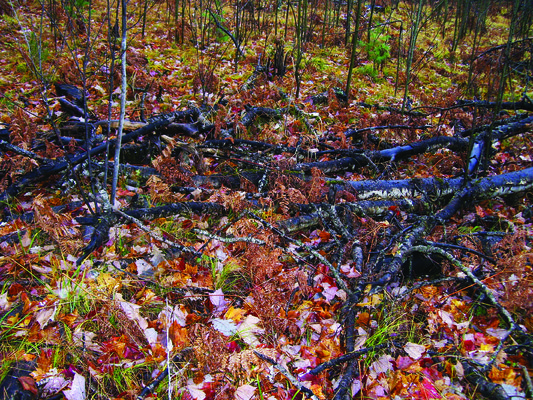
by Chris J. Peterson Thursday, January 5, 2012

Termiticide treatments, although costly and destructive to property, are usually necessary in termite-prone areas. Chris J. Peterson

Termites and wood-decaying fungi quickly dispose of downed trees in southern U.S. forests, such as this one in Mississippi. Chris J. Peterson

But northern forests, such as this one in Michigan's Upper Peninsula, lack termites and are still choked with downed trees. B. J. Peterson
As a child growing up in Iowa, every summer I looked forward to our family’s annual trip to the woods in Michigan’s Upper Peninsula. One of the highlights was going to “camp,” an old logging camp my grandfather purchased in the 1940s and maintained as a deer camp and weekend getaway. Off-road hiking in the Northwoods was slow. We had to maneuver our way around downed logs that sometimes piled two or three deep, and climb over a profusion of old stumps still charred from a massive fire that had burned through the area three or four decades before.
Today, I live in Mississippi, where a trek through the woods is a different experience. If you’re lucky enough to find a wooded area that isn’t choked with yaupon, catbrier, holly and vines, you can walk freely, unencumbered by downed wood or stumps. In Mississippi, fallen logs decompose in a few years, and do not accumulate on the forest floor. A burned-out stump wouldn’t last 30 or 40 months, let alone 30 or 40 years.
Why the difference? Termites.
Termites are ubiquitous in Mississippi, where no wooden structure or dead log is immune to the insect’s powerful jaws, but in Michigan’s Upper Peninsula, termites are almost unheard of. My grandfather’s camp is made entirely of wood and sits on a concrete slab with just a centimeter or two of clearance between the soil and the wood. The main part of the building is more than 70 years old and has never once had a termite. In fact, termites are so rare that preventative treatments for termites are not required in the Upper Peninsula.
But someday my grandfather’s camp may need some termite-proofing. With warmer conditions creeping northward as the climate changes, especially in the winter, termites will likely expand their territories to higher latitudes. And because those areas are not equipped to handle termites, this could cause untold billions of dollars in property damages, unless we prepare for the coming changes.
In the United States, the most common and widespread termites, and therefore those that cause the most damage, are the subterranean termites, the family Rhinotermitidae and more specifically the genus Reticulitermes. Three species in this genus occur in the eastern United States, a fourth species occurs only on the West Coast, and a fifth species is primarily restricted to the Rocky Mountains. There are a couple of other species of termites in other genera that tend to be more localized and therefore cause localized destruction. The Formosan termite, which belongs to a different genus and originated in southern China, has garnered much attention because of the size of its colonies and the speed with which it can consume wood. But as of now, due mostly to quarantine efforts and the species’ temperature dependence, the Formosan termite is not widespread in North America and only causes damage in localized areas, most notably New Orleans, La.
Generally speaking, termites in North America get more common the farther south you go. In Canada, termites are native only to British Columbia. Isolated infestations (now reportedly eradicated) have been found in southern Manitoba and Alberta, but are becoming more common in southern Ontario, especially in Toronto. Infestations outside of British Columbia, including those in Toronto, are likely due to accidental introduction through human activities.
Taking all of these termites together and estimating the relative hazard of termites to structures, we find that currently the greatest risk of termite damage is still in the Southeast — from North Carolina to central Texas and south to the Gulf Coast and Florida — and in California. A lesser but still significant risk extends northward along both the East and West coasts, while the least risk is generally in the Great Plains — although no part of North America is completely immune to a termite’s appetite.
Global climate change has implications for the abundance of termites in areas where they are not currently common. In 2007, the Intergovernmental Panel on Climate Change (IPCC) released its predictions for worldwide climate change for the next 100 years, and reported that most of North America will become warmer and many parts will become wetter. The area of North America that is of immediate concern for termites — from the Gulf of Mexico to the southern shores of Canada’s Hudson Bay — is predicted to see an increase in annual mean temperature of 3 degrees to more than 4 degrees Celsius over the next 100 years. Areas even farther north are expected to warm to an even greater degree and experience higher precipitation, especially in the East. But more than higher annual temperatures, it’s the winter temperature increases that matter the most. In the area of immediate concern, winter temperatures are predicted to increase by up to 7 degrees Celsius, and extreme cold events are expected to decrease in frequency.
This portends problems. Most termites die off during the winter in areas where the ground freezes: Most species cannot survive sustained temperatures below 9 degrees Celsius, and even fewer can survive temperatures below 1 degree Celsius. Thus the increase in the winter temperature in the North will affect termite populations largely because as winter temperatures warm, termites may be better able to survive winters in more northern climates. Scientists don’t know exactly how termites spend the winter in areas where the depth to which the soil freezes (the frost line) is significantly deep, but researchers assume that termites survive in soil below the frost line. Central heating might also help termites to survive, with the assumption being that heated basements keep soil above freezing throughout the year.
This is consistent with observations by Timothy Myles, termite officer for the City of Guelph, Ontario, who notes that termites are found in residential areas and not in forests. It is also possible, and has been demonstrated in laboratory studies, that termites move downward in the soil in response to declining temperature — the implication being that they do this to avoid freezing. A final possibility is that termites do not move in response to cold, and those above the frost line simply die, while those below the frost line survive to rebuild the colony the next year. If climate change causes progressively shallower frost lines in the winter, more termites should survive the winter, allowing populations to build and spread more easily.
Meanwhile, higher summer temperatures in the North might allow any termite populations already present to increase in size. In southern states, a newly formed termite colony starts with two reproductive individuals and then builds for several years until it reaches a certain size. At that point, winged, or alate, termites capable of reproduction begin to appear. In the spring, thousands of these alates from many colonies take flight (sometimes called a swarm). Adults pair up and start new colonies, reinitiating the cycle.
Termites in Toronto have produced alates, according to Myles, but they do not appear to fly to produce new colonies. This might be because the temperature remains too low for the necessary physical and behavioral changes to take place that allow the flights to happen. Any new colonies that do form are likely killed off by the winter freeze.
But if temperatures in Toronto and across the North increase, all bets are off. The development rate of insects is dependent on temperature. For certain developmental and behavioral changes to take place (such as the foundation of new colonies), the high temperatures must be sustained. The required temperature and time are genetic, and vary with species and the particular change being considered. Currently, it seems that the Toronto summer does not stay warm enough for long enough for dispersal flights to occur and thus for termites to spread farther into the region. But with warmer winters, termite colonies could survive; with a warmer spring, developmental changes might start occurring earlier in the year. And a warmer summer might accelerate these changes, allowing termite colonies to initiate flights.
Precipitation changes will also have an effect. Termites, being soft-bodied, are prone to water loss and death by desiccation in soils with less than about 8 to 10 percent moisture by weight. So regions such as the Southwest, east Texas and parts of Louisiana, which are predicted to experience less rainfall and higher temperatures over the next 100 years, may see a decline in termite populations. However, although populations of less heat-tolerant and more moisture-dependent species might suffer due to hotter and drier conditions, other species that are better adapted to higher heat and lower humidity might become more common in those areas, exchanging one headache for another.
Increase in summer rainfall in the North, meanwhile, coupled with the warmer temperatures, should favor termite growth in areas where moisture is presently limiting their growth. As conditions in these areas approach those seen to the south, any termite populations already present might expand. Although there is evidence that termite populations can be suppressed by inundation in wet years, this effect is likely only seen locally in poorly drained soils. Termites can survive almost indefinitely in saturated soil, provided that there is no standing water to flood their tunnels.
Climate change has already affected the lives of North American insects. The first “greenness” in the North American spring has come 10 to 14 days earlier since 1981, according to the IPCC. The average first spring flight of 23 species of butterflies in California occurs earlier now than it did in 1972. And the skipper butterfly has expanded its northernmost range on the West Coast by more than 300 kilometers over the past 30 years into areas that were previously too cold to support a full life cycle.
If these examples are any indication of the response by termites to changes in climate, then we should expect them to develop more quickly and to expand northward too. At what rate? We don’t yet know. However, because termites, barring human activities, move slowly on their own, it may take longer to notice the effects than it does for butterflies. Furthermore, there aren’t formal abundance surveys for termites, so we don’t have a good sense yet of what termite populations might be doing.
The areas most vulnerable to expanded termite populations will be New England, the upper Midwest and southern Canada. How quickly and how drastically temperatures and precipitation change across northern regions will determine how quickly termite populations move. It is likely that changes in termite populations will keep pace with gradual warming. How much termite damage will increase in these areas will thus depend on the degree to which the climate changes, but also the degree to which termite-preventative measures are taken.
In terms of termite preventative measures, the North is again most likely to see the biggest changes. The Southeast should not see many effects because most of their structures have already been treated or are otherwise constructed to minimize termite infestation. Few (if any) preventative measures have been taken farther north. In upper New England, the upper Midwest and into Canada and Alaska, where few to no structures are treated, damage will become more severe and widespread. These regions will incur costs for repairs and treatment.
In addition, legislators and building code boards in these areas will have to decide which, if any, preventative measures to incorporate. Preventative treatments usually consist of soil-applied termiticides, termiticidal baits, treated wood or physical barriers, but the allowed treatments vary from state to state. Only a handful of states — Alabama, Arizona, Florida, Hawaii and North Carolina — require termite preventative treatments in their building codes at the state level. Other states are discussing the issue but have not yet adopted any formal measures. Many, if not most, states allow county or municipal governments to incorporate these requirements into their building codes if they so choose. At least some communities in most states have done so, and in some southern states, all counties have.
Although states might not require termite preventative measures, many
mortgage-lending institutions do. The U.S. Federal Housing Authority
(FHA), part of the Department of Housing and Urban Development, has
established that termite inspections or preventative treatments are
required to secure a loan in all or parts of 40 states. Private mortgage
lending institutions might follow different guidelines, but they
probably do not differ significantly from FHA’s.
In the future, if termite populations do spread, more states, counties
and local governments will need to adopt these termite regulations and
policies. Furthermore, short of requiring retroactive treatment of all
existing structures, those structures that were built before the new
policies were in place will remain vulnerable to attack.
Unfortunately, we cannot accurately project how much potential termite damage may cost as a result of climate change. We do not precisely know the effect of temperature and rainfall on termite population growth, and we know even less about how termite population affects the amount of damage to a structure. We can only say in a general sense that termite populations will likely increase everywhere, with the possible exception of the Southwest and eastern Texas, and structures with no treatment or a failed treatment will be more likely to be damaged by termites. And though termites in northern areas have so far been easily eradicated once they are found, once warming temperatures allow them to become more established, infestations will become much more difficult to eliminate, and control strategies will have to switch to management instead of eradication.
Does this mean those of you in the Northwoods should immediately pick up the phone and schedule a termite treatment? Not just yet. The climate changes predicted by the IPCC are 100-year projections and termite populations move slowly. So if you do not have termites in your area now, you probably have at least a few years until you’ll start seeing them. But when you do start to see them pop up, schedule a formal termite inspection of your property and discuss which, if any, treatment options are available that meet your needs.
© 2008-2021. All rights reserved. Any copying, redistribution or retransmission of any of the contents of this service without the expressed written permission of the American Geosciences Institute is expressly prohibited. Click here for all copyright requests.